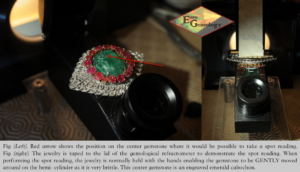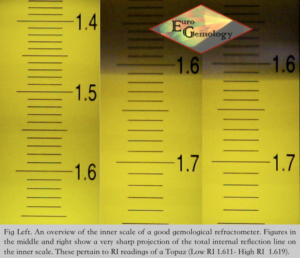Gemological Refractometer
 The understanding and usage of a gemological refractometer requires an excellent theoretical knowledge of crystallography, advanced gemological refractometry, practical skills, experience, patience and precision. Having an immersion polariscope with ¼ retardation plate can give absolution on the fact whether the gemstone would either be isotropic, uniaxial or biaxial; also, it can visually reveal the optic sign of the uniaxial gemstones. When only depending entirely on your gemological refractometer readings, it can be a challenge to determine the gemstone in some cases. For instance, in theory, uniaxial gemstones should have either the low RI or high RI readings to be constant but in practice this is often not the case. Therefore it is important to have sufficient readings, meaning 8 readings on 2 different facets, at a rotation of 45 degrees on each reading. Preferably read one facet on the crown side and one on the pavilion side, this could expose immediately when dealing with a doublet. The table facet would be the easy choice on the crown side, but it’s not always the best choice as some gemstone’s table facet has been cut parallel or perpendicular to the optical axis/es (this can be interpreted by specific RI readings). In case you are sure of the gemstone being uniaxial +/- through polariscopic research, then 4 readings are sufficient. Beware that birefringence could be less accurate with only 4 readings.
The understanding and usage of a gemological refractometer requires an excellent theoretical knowledge of crystallography, advanced gemological refractometry, practical skills, experience, patience and precision. Having an immersion polariscope with ¼ retardation plate can give absolution on the fact whether the gemstone would either be isotropic, uniaxial or biaxial; also, it can visually reveal the optic sign of the uniaxial gemstones. When only depending entirely on your gemological refractometer readings, it can be a challenge to determine the gemstone in some cases. For instance, in theory, uniaxial gemstones should have either the low RI or high RI readings to be constant but in practice this is often not the case. Therefore it is important to have sufficient readings, meaning 8 readings on 2 different facets, at a rotation of 45 degrees on each reading. Preferably read one facet on the crown side and one on the pavilion side, this could expose immediately when dealing with a doublet. The table facet would be the easy choice on the crown side, but it’s not always the best choice as some gemstone’s table facet has been cut parallel or perpendicular to the optical axis/es (this can be interpreted by specific RI readings). In case you are sure of the gemstone being uniaxial +/- through polariscopic research, then 4 readings are sufficient. Beware that birefringence could be less accurate with only 4 readings.
Quality of Gemological Refractometer
Choosing a good gemological refractometer is a mission by itself. As it will be your most used instrument, it must be of the highest possible quality and precision. These are not obvious factors nowadays, so it requires you to check every gemological refractometer individually prior to buying it or using one from somebody else. Use a personal calibration gemstone that must be measured every time on the “to be used” gemological refractometer in order to be sure that the equipment has no aberrations or malfunctions and to verify the accuracy of the RI readings. This is a required discipline. A good refractometer will make the difference in complicated situations.
Here below is a list of checkpoints that could prevent you from having bad quality refractive index readings. The refractometer should not fail on these listed points.
 – Once the refractometer is calibrated for your eyesight, the entire scale should be 100 percent in focus right down from the lowest refractive index to the highest refractive index. This is a very important factor to perform a spot reading or distant vision method.
– Once the refractometer is calibrated for your eyesight, the entire scale should be 100 percent in focus right down from the lowest refractive index to the highest refractive index. This is a very important factor to perform a spot reading or distant vision method.
– The total internal reflection line (shadow – light) should be 100 percent straight and hair sharp. In certain cases, blurry readings could be the indication of a treatment, so, if your refractometer is blurry by nature, you will fail to notice this or get no readings at all.
– Ensure that the gemological refractometer has absolutely no spherical aberration.
– No dust particles should be present on the inner part/scale of the refractometer.
– Check for any possible leakage near the hemi-cylinder, as in some cases the hemi-cylinder may not be glued in very well.
– Verify if the refractometer/contact fluid allows you to read the highest possible refractive index that can be measured on your gemological refractometer, in most cases 1.81. (Beware, this liquid can be harmful to health)
– Perform some spot or distant vision readings over the entire scale, with Low-Mid and high RI gemstones. Do not remove the polarizer. Don’t forget to rotate the polarizer.
– Test the accuracy of your refractometer with a gemstone that you personally use to verify the refractive index accuracy.
* The angle and strength of the light entering the gemological refractometer plays a great role in the quality of the projection of the total internal reflection.
* It is beneficial to have a refractometer with a great protrusion of the hemi-cylinder. This can work in your advantage, especially when dealing with mounted gemstones. In the same product brand, it can still vary from one refractometer to another. Therefore, it is advisable to check multiple refractometers prior to buying.
Importance of Body Position
As mentioned before, the theory of refraction in gemstones (crystallography) and their specific refractive indices are quite often not straightforward that in practice, the results have to be interpreted in some cases (e.g. the gemstones RI readings showing to be biaxial when the gemstone is actually uniaxial or the birefringe measuring too large, etc…) The downside is that, these phenomena can also appear due to inaccurate readings, in other words human error. The only thing that MUST be the same is the consistency of the refractive index (RI) readings, and the only way to achieve this is to have the same body position for every reading over and over. This can never be emphasized enough. The eye must look perpendicular and exactly through the center of the ocular. To achieve this, your head position must exactly be the same each time when approaching the refractometer, and so must the distance between the eye and the ocular be the same. The goal is to be so consistent that your refractometer readings can be reproduced all over again, when observing the gemstone in the same crystallographic orientation. This might seem obvious but it isn’t, it is a true art by itself. By moving your eye slightly higher or lower when observing through the ocular, the RI reading will change, as it will be read on a different place on the scale resulting in incorrect RI readings. When this error occurs on the low and high RI readings, it will cause the birefringence calculation to be faulty as the consistency is never the same and therefore not reliable at all. It could also have consequences on the determination whether the gemstone is uniaxial or biaxial when only depending on these bad RI readings. When dealing with interchangeable gemstones, the accuracy of the RI readings are even more important to differentiate them. This requires practice and more practice.
Example, when you are observing an RI of 1.543 in your gemological refractometer, by looking away and again through the refractometer without changing the position of the polarizer and gemstone, the reading might be 1.544 and the next one again at 1.542 etc…. This should NEVER happen. If this is the case, it’s most likely that you had taken in a bad body position or you shifted your position. Seeing the shadow line does not mean that it’s observed on the right position on the scale. The distance – angle between the head (eyes) and the gemological refractometer, should always be exactly the same. One hand can be used to make a triangular setup between the position of the refractometer and the head. It is advisable to train with isotropic gemstones.
This kind of aberrations will play a great role in gemstones with a small to very small birefringence, like Apatite.
Spot Reading or Distant Vision Method
 Once consistent readings are achieved, it is time to move on to the Spot Reading or Distant Vision method. This technique can make the difference in being able to determine the gemstone or not. With cabochons, it is a relatively easy procedure, but it becomes most rewarding when it can be executed on facetted gemstones mounted in jewelry where only the tiniest facet would be able to be measured. Only use the smallest possible drop of contact fluid, the smaller the better. For this, you are required to practice with the smallest possible cabochons, holding them with a pair of gemological tweezers to the hemi-cylinder, while reading the RI and rotating the polarizer with the other hand. Next phase is holding a gemstone on it smallest facet down to the hemi-cylinder. This is a rather very difficult technique and requires a very stable hand. When the gemstone is mounted it is slightly easier, as you can hold the gemstone by its attached alloy. In past case studies where gemstones with a rather large facet, didn’t give any readings at all but by performing the spot reading method it was possible to get a vague reading. It also helps when you are dealing with gemstones that present heavy wear. In other words, if you don’t achieve to get RI readings on the conventional method, always execute a secondary spot reading method. Never forget to rotate the polarizer as anisotropic gemstones with a large birefringence (e.g. Rhodochrosite, Malachite) could have the high RI reading higher than 1.81.
Once consistent readings are achieved, it is time to move on to the Spot Reading or Distant Vision method. This technique can make the difference in being able to determine the gemstone or not. With cabochons, it is a relatively easy procedure, but it becomes most rewarding when it can be executed on facetted gemstones mounted in jewelry where only the tiniest facet would be able to be measured. Only use the smallest possible drop of contact fluid, the smaller the better. For this, you are required to practice with the smallest possible cabochons, holding them with a pair of gemological tweezers to the hemi-cylinder, while reading the RI and rotating the polarizer with the other hand. Next phase is holding a gemstone on it smallest facet down to the hemi-cylinder. This is a rather very difficult technique and requires a very stable hand. When the gemstone is mounted it is slightly easier, as you can hold the gemstone by its attached alloy. In past case studies where gemstones with a rather large facet, didn’t give any readings at all but by performing the spot reading method it was possible to get a vague reading. It also helps when you are dealing with gemstones that present heavy wear. In other words, if you don’t achieve to get RI readings on the conventional method, always execute a secondary spot reading method. Never forget to rotate the polarizer as anisotropic gemstones with a large birefringence (e.g. Rhodochrosite, Malachite) could have the high RI reading higher than 1.81.




